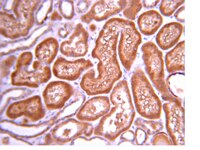Mobilization of mesenchymal stem cells by stromal cell-derived factor-1 released from chitosan/tripolyphosphate/fucoidan nanoparticles.
Yi-Cheng Huang,Ting-Ju Liu
Acta biomaterialia
8
2012
Show Abstract
Stromal cell-derived factor 1 (SDF-1) is an important chemokine in stem cell mobilization, and plays a critical role in the biological and physiological functions of mesenchymal stem cells (MSC). However, the use of SDF-1 in tissue regeneration is limited by two drawbacks, which are its short half-life and ready degradation by enzymes. This study investigates the release of SDF-1 from chitosan-based nanoparticles (NP) and evaluates the effect of released SDF-1 on the migration of MSC. Among the prepared chitosan-based NP a chitosan/tripolyphosphate/fucoidan (CS/TPP/F) NP is the most effective carrier for SDF-1 release. CS/TPP/F NP are spherical and effectively encapsulate SDF-1. The CS/TPP/F NP protected SDF-1 against proteolysis and heat treatment and controlled its release for up to 7 days. The concentration of released SDF-1 reached 23 ng ml(-1). According to in vitro experiments on cells the released SDF-1 retained its mitogenic activity, promoted the migration of MSC and enhanced PI3K expression. Biocompatible CS/TPP/F NP may be effective as carriers for the delivery and controlled release of SDF-1 to mobilize stem cells in tissue engineering applications. | 22200609
 |













